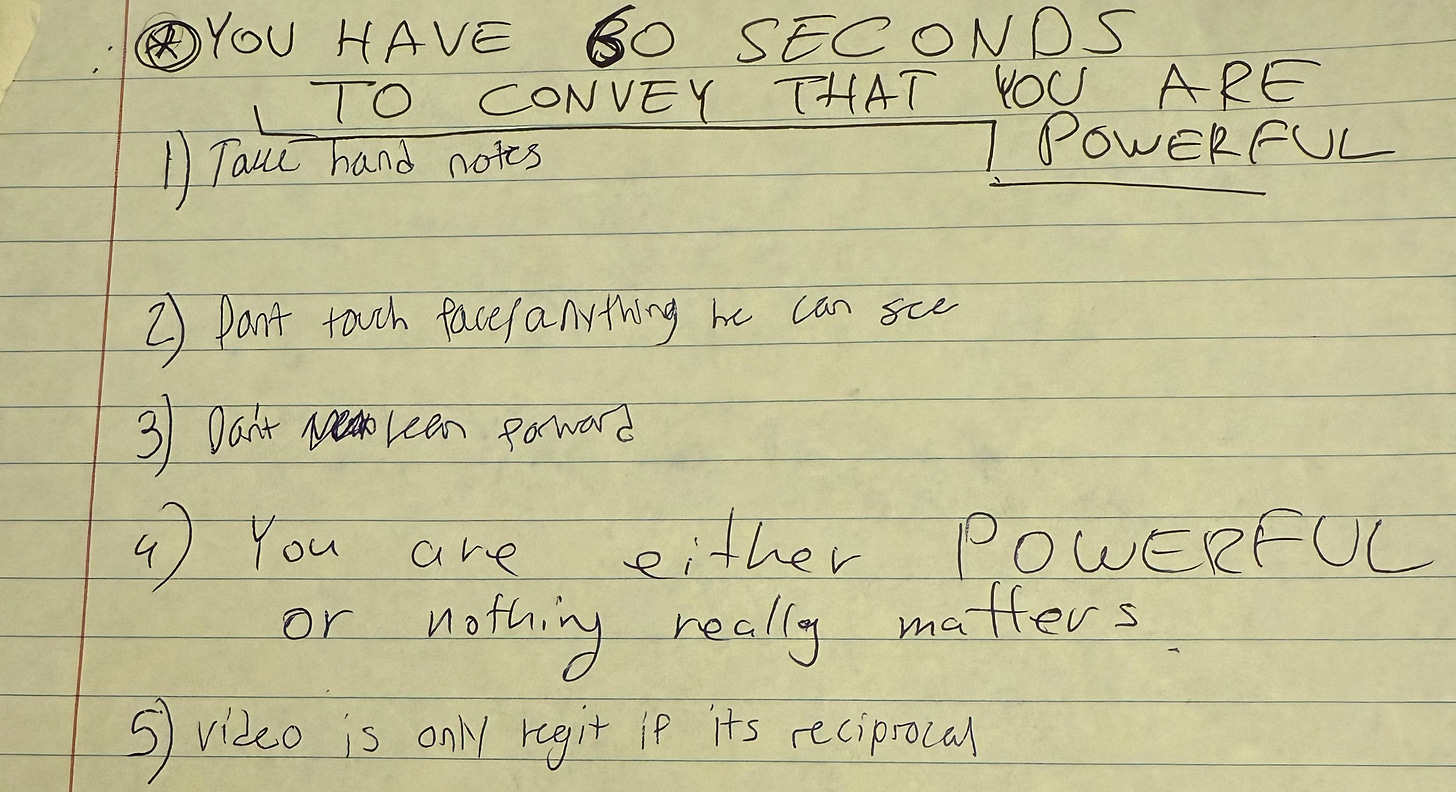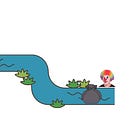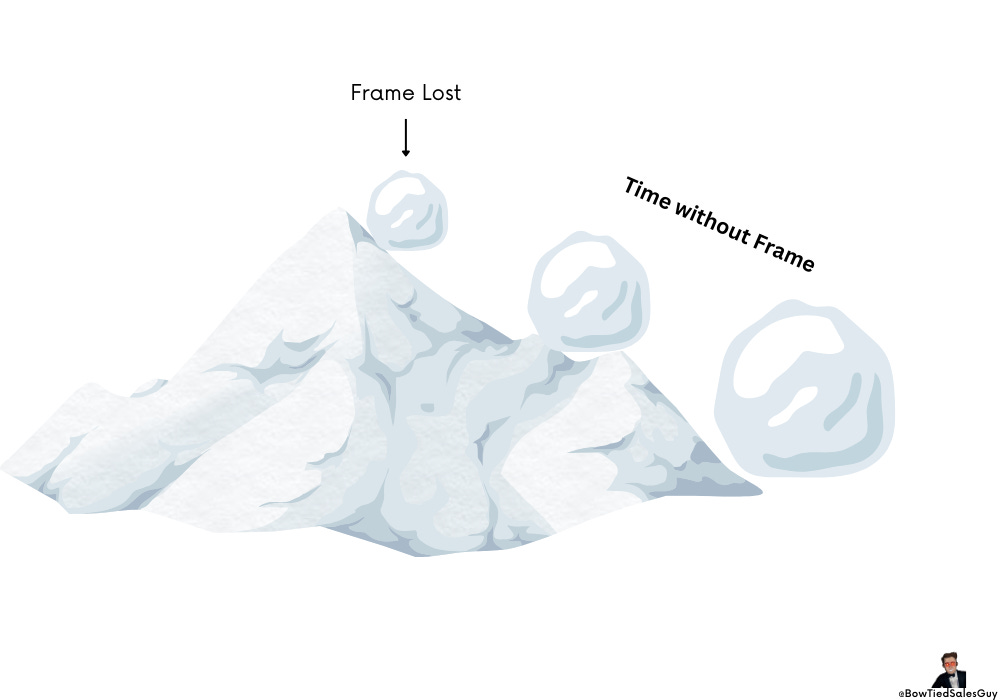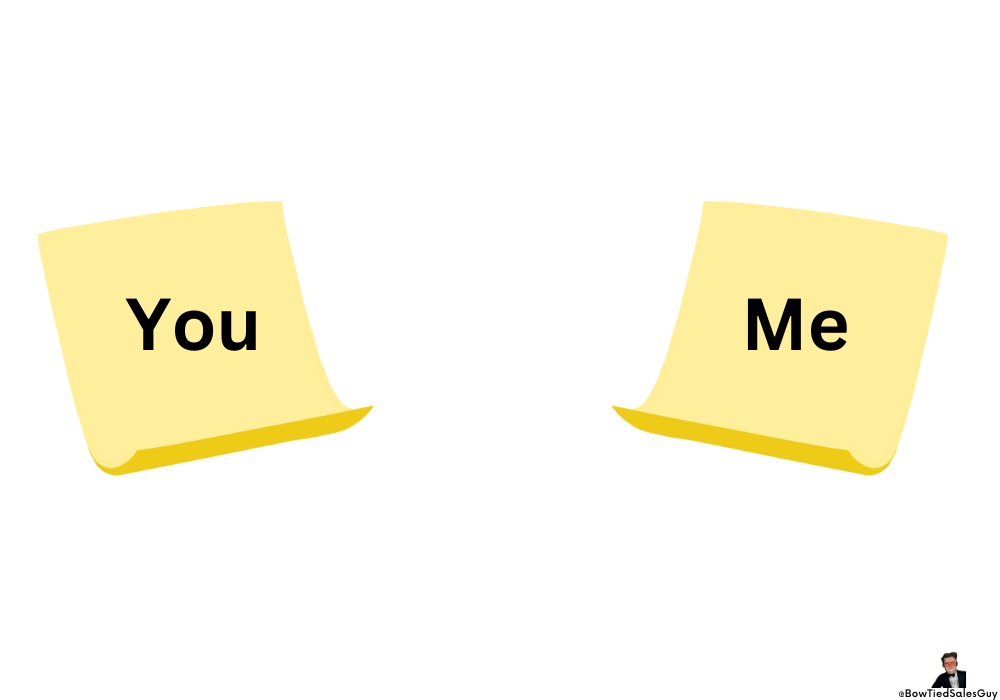10 sales lessons I learned from Giga Chad
10 year Chadiversary
It’s been nearly a decade since I crossed paths with my mentor, Giga Chad.
He introduced me to the world of B2B sales. He set me on the path.
His wisdom came in many forms. Sometimes through direct teaching, other times through observation of him.
I recently found scribbled notes him and I wrote together in those early days.
Implementing these 5-6 points alone was a game changer for me. I immediately felt more powerful at the start of my meetings and the buyer adapted accordingly too.
Beautiful thing to see and experience. Truly.
That’s when I realized we have a lot more control of our outcomes than we give ourselves credit for.
and in sales, how you start largely influences how you finish so it makes sense to overly emphasize the first few minutes.
The rest of this post will build on these notes, sharing what I believe to be the 10 most significant lessons in dealmaking I learned from him.
Enjoy!
1) You have 60 seconds to convey you are powerful
“Why only 60 seconds?”
🐲: Because that’s when their initial & strongest perception of you is formed.
“What happens if you fail to convey power in the first minute?”
🐲: You’re f*cked. Nothing you say or do after that will matter because they will see you as the beta (Low Status).
🐲: *Proceeds to write ‘You are either POWERFUL or nothing really matters’*
“I’ve obviously closed deals without doing this or even being mindful of it, so what gives, Giga Chad?”
🐲: How hard did you work for those deals? How good were the terms? Did you have to discount?
*silence*
My mentor taught me that if I’m not proactive about taking the high status position at the start of a meeting then I will be put in the low status position.
🐲: You gotta come out the gate swinging.
And so I made some changes to my verbal / nonverbal communication:
I’d lean back into my chair. Calm, relaxed, and *slightly* bored. When they’d lean in, I’d lean back in order to reinforce the dynamic that they’re chasing me, not the other way around.
I’d emote slightly less than the buyer rarely exceeding their emotional state / vibes in order to remain in control.
I’d wait for them to say “Hi” first in the beginning of the meeting to which I would reply with a neutral / downward inflection.. speaking from my diaphragm. They’re entering my world.
I’d use phrases like “good to connect” with a friendly smile instead of the typical enthusiastic / nervous “great to meet you!” with a full smile.
If you give them the impression this meeting is the best part of your day, you are being needy.
“Giga Chad, these are a ton of rules to remember. Are they really necessary?”
🐲: *slap* .. This all might seem overly rules based.. but the rules are there to give you structure and to help you learn until it becomes engrained.
There was a method to the madness.. the purpose of all these lessons was to reinforce that I, the seller & the one with the solution, am the prize. Not the buyer / their money.
This was the beginning of establishing myself as a Domain Authority.
Someone the buyer can feel comfortable deferring to in order to help them.
And the truth is they wanted this too.
Deep down people crave certainty.
Give them what they want & need and get paid for it.
—
The genius of “You have 60 seconds to convey you are powerful” is also in the Framing of it.
The ‘60 seconds’ bit is a time constraint serving to focus my attention on the first 60 seconds. I became more self aware of what I was doing when it mattered most. This was the Pareto Principle found in Status Dynamics.
It was also efficient. ~1 minute of maximum intention in order to solidify my perception of Authority.
At first it was stressful and I made many mistakes (i.e being too stiff / robotic, being too friendly, etc.)
Over time I learned how to calibrate and it became second nature.
—
Pro tip
Starting from the High Status position is more credible when the buyer doesn’t know you. A strong initial presence gives you buffer room.. minor mistakes won't significantly damage your perception because your first impression established authority.
You can gradually soften this position over time. And it will be more rewarding when you do it.
But starting Low and then attempting to elevate your Status later is often perceived as manipulative and will raise their defenses.
2) Take hand notes
Giga Chad was adamant about taking hand notes for a few reasons:
Taking notes by hand visibly demonstrated I was present and actively listening
I gave off “Doctor/Therapist” vibes commanding attention whenever I looked up from writing (increasing the value of eye contact)
It forced me to write down only the essential notes while subcommunicating to the buyer that I was discerning and had good judgement (bonus Delta points for me.. see tip #8 for reference)
It helped slow the conversation down
Drawing / Sketching on the paper helped me neutralize anxious energy which helped to lower inhibition and promote spontaneity. I became present again.
With all the AI note taking tools available nowadays, taking hand notes is a strong pattern interrupt. I encourage you to try it and see if it helps you.
At first it may feel clunky but over time your relationship to the pen and paper will improve.
**Yes you can and should still be using AI note taking apps. Combine it with pen / paper.
3) Don’t touch your face or anything the buyer can see
Face touching is often interpreted as “Self soothing” behavior that indicates to the buyer you are nervous and uncomfortable.
Those negative vibes will get transmitted to your buyer (via mirror neurons)
And now your buyer feels nervous and uncomfortable too.. *with you*
How do you think that impacts their confidence in you, anon?
DON’T TOUCH YOUR FACE.
Watch any high status character on TV or live, you’ll notice they don’t really move their head while speaking or touch their face unless they’re doing so intentionally in order to punctuate their message.
Good examples of characters to look at:
Harvey Specter - Suits
Don Draper - Mad Men
Stephen Amell - Arrow
Their movement is mostly slow, relaxed, and deliberate.
Don’t lean forward
Another nervous habit is leaning forward. You are physically entering the buyers Frame with the subtext being “seeking security and connection”
It’s a physical manifestation of chasing.
Chad note: The flip side of this is it can show engagement and help to punctuate a message which can be seen as a positive.
But in my experience, most sellers don’t have an issue with “not enough engagement” .. They are often too engaged in the interaction which is what makes them nervous.
Ideal state is Calm, Relaxed,
and Moisturized.
4) Video is only legit if it’s reciprocated
Don’t leave your camera on if the buyer has theirs off.
Think about it.. you’re fully visible to their scrutiny while they maintain the upper hand behind their screen.
It’s also disrespectful on the buyer side to leave you on an Island like that. How do you know if the buyer is even present with you and not distracted?
If they can’t extend you the courtesy of having their video on too, then you turn yours off.
If you start the meeting with yours on and theirs is off, you can say:
🐲: Hey John, I can’t see you.
If they want to keep theirs off:
🐲: No problem. I’ll turn mine off too.
That way you level the playing field.
*It’s also totally reasonable to reschedule the meeting to when they can have their video on.
Makes for more productive meetings.
Meet in person if you can
Always preferable to meet in person than over Zoom!
My biggest / most significant deals? In person.
5) Every sale is a Frame game
My mentor believed that there’s conflict inherent in every sale.
When buyer and seller meet, they each bring their own Frame - a point of view (POV) shaped by their beliefs, assumptions, values, and biases. Frame determines how each side views the entire situation.
These Frames often clash, naturally, because the buyer sees the world one way, and the seller another. And therein lies the conflict.
Deals move when:
One Frame emerges as dominant and/or compelling enough for the other side to adopt, even temporarily.
There is enough alignment / overlap between the 2 from the beginning.. i.e small conflict.
Examples
The Sellers Frame is the more dominant one leading the Buyer to “Closed Won”
The Buyers Frame is the more dominant one by either leading the deal towards a ‘Yes’ (i.e order taking) or towards a ‘No’
There is no avoiding the conflict.
Some tension will be present in every deal because someone’s perspective has to shift in order to move forward.
And that can be uncomfortable depending on how incompatible the 2 Frames are at first.
Chad note: Most deals are lost to the Status Quo because both parties are locked in incompatible Frames.
Additional context
Frame control isn't binary, it's fluid. Frame gets passed back and forth throughout the deal cycle based on each move and the reaction to each move by Buyer / Seller. Problems arise when the Sellers Frame is lost and not recovered.
You can maintain Frame Control while accepting certain buyer constraints. For example, you can acknowledge their requirements and processes, but control how you navigate them.
The moment you start compromising your Frame (discounting, chasing, being overly pushy, etc), you've lost control regardless if you close the deal.
Professionals care about how they get results.
6) The longer you go without control of the Frame, the harder it will be to regain the Frame
Frame loss compounds over time making it increasingly difficult to course correct later.
When sellers ask me about difficult situations, I can often trace the problem back to earlier Frame losses they missed.
All your sales problems are a result of problems that happened upstream.
What you did or didn’t do upstream affects everything downstream.
Related reading:
—
Think of a snowball rolling down hill progressively getting larger and less manageable over time:
As time passes, the buyer becomes more entrenched in their Frame (perspective) because of confirmation bias.
Everything happening afterwards only serves to strengthen their Frame.. essentially creating a self reinforcing downward spiral loop of f*cking you.
The Downward Spiral
Step 1: Lose Frame
Step 2: Buyer interprets your actions through their negative frame of you
Step 3: This interpretation confirms their bias / perspective
Step 4: This reinforces and strengthens their Frame
Repeat into a downward spiral.
The longer it continues, the harder it is to get out.
—
This is why you gotta “Swat away” their attempts at taking control. Immediately.
And if they do gain control you need to quickly restore balance.
There is no “Oh, haha I see what they did there! I’ll just deal with that later”
No.
You see a threat to your deal you need to deal with it immediately.
7) “You/Me”
Those that have my course know this one.
Learning what Frame Control feels like in a meeting can be complicated at first because of its subjective experience.
My mentor taught me to write “You” on one side of a piece of paper and “Me” on the other side.
During my sales meetings, I’d flip the paper whenever I sensed the Frame shifting.
As I gained experience, I began to feel the difference between having and losing Frame.
These visceral experiences deepened my understanding because emotions were now part of the learning process.
Eventually, these teachings became so integrated that I could listen to client recordings and immediately pinpoint the exact moments where Frame shifts occur and understand why.
8) Fight for every little bit of delta
In every buyer / seller interaction you have a Status Gap. This is the contrast, or delta, in status between the 2 (or multiple parties)
Examples
Experienced Seller selling to uninformed prospect (B2C) would indicate a Small Status Gap in the Seller’s favor.
Startup Seller selling to C Suite of large B2B company would indicate a Big Status Gap against the Seller
Seller at reputable company selling to C suite of smaller less known company could indicate a Smaller Status Gap against the Seller or the buyer.. could go either way depending on additional details / context.
Chad note: Notice how the details / context can impact the Status Gap before the parties even meet?
You and the buyer will be saying / doing things throughout the your interactions that will either raise or lower status, which adds to the Delta in the Status Gap.
Fight for every delta point. Keep subtly raising your status in order to widen the delta of the status gap in your favor.
The larger the gap in your favor, the more influence you wield.
The larger the gap in your buyers favor, the more pressure there will be to adopt their Frame.
This one lesson alone has been a total game changer for me and why I dedicate an entire session to Status Dynamics, and how to influence them, in the Accelerator.
9) Good Reframes are Frame Inclusive
One way my mentor taught me to Reframe was to make sure that my Reframe was “Frame inclusive” which meant including the Buyers perspective, not dismissing it.
Example
Buyer: We’re concerned about implementation time since we need to train 50 people on this
🤡: That won’t be a problem. Our platform is so intuitive that getting them up to speed will be simple.
^ Dismissive tone masked as reassurance. Oversimplification demonstrates lack of experience. The confident tone becomes evidence of their naivety and/or dishonesty.
🐲: I get it. Rollout efficiency is a priority for us too which is why our approach to implementation is [explain process].. how does that sound so far?
^ Acknowledges their concern. Reframes their concern as something you actively focus on, not just respond to. Provides the buyer with specific details. Shows you’re attuned to their reactions with “so far?”
also “so far” = frontloading their concern of uncertainty and sets the buyer up to give the seller more details on a positive note while leaving room to be “Frame Inclusive”
10:) Intrigue before “Value”
Sellers waste a lot of time trying to deliver value before there is any intrigue.
While something that is high value can naturally create intrigue, in today's world where most solutions (especially in tech) are comparable, you the seller / marketer need to deliberately elicit intrigue first in order to open the door for persuasion.
Think of it this way..
Intrigue is the hook.
Value is the anchor.
I would watch in disbelief as my mentor would send vague 1-2 sentence cold emails with typos and quickly get responses from senior executives at big companies.
Now looking back it makes total sense.
He was doing the opposite of “best practices” which was intriguing.
If your “value” driven cold emails aren’t working well for you, then try doing the opposite.
You never know..
🐲: Hi John, my name is Katie and I’m with [company]. we’re a boutique XYZ agency working with a few companies in your space such as [company 1], [company 2], and [company 3]. should we explore some opportunities too?
Pro tips
Your buyer should be thinking “someone definitely wrote this. no way it’s AI”
Aadd in a little spelling mistake
don’t capitalize every beginning of sentence
use acronyms
play with spacing .
Chad note: Use these techniques sparingly. Combining too many in one message will defeat the purpose.
Programs & Trainings
The Accelerator
A high intensity 12 week group coaching program. Limited to 10 participants. Through live sessions and active roleplaying, you'll learn how to deeply understand your buyers, ask powerful questions, and be in control of your deals.
More details here:
—
if you’re ready to enroll, you can also fill out the form here:
The Chad Salesman Course
My flagship course. A no-BS self study course that transforms average sellers into top performers.











Watched 100s of sales «experts». no one comes close to BTSG 🐲
Ridiculous amounts of knowledge dropped every post. Not only for sales but day-to-day interactions, too. Communication and control is an art and it’s amazing to learn from those who have developed these skills. Thanks always SalesGuy